Asparagus Plumosa Fern: How to Care For Plumosa Fern (Asparagus Plumosus)
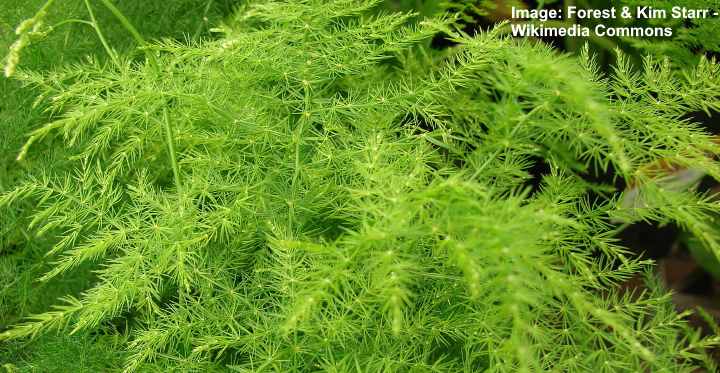
Asparagus plumosa ferns are ornamental perennial plants with long, soft leaves that grow like feathery clumps. Asparagus ferns get their name from their fern-like foliage. However, asparagus ferns are in the Asparagaceae family and not classified as true ferns. Asparagus plumosa ferns are also called lace fern, climbing asparagus, asparagus grass, or ferny asparagus.
Asparagus plumosa ferns have the botanical names Asparagus setaceus, Asparagus plumosus, and Protasparagus setaceus. But all these botanical names refer to the same plant which is the common asparagus fern or plumosa fern.
The reason asparagus plumosa ferns are called ferns is because their resemblance to ferns. The feathery foliage of evergreen asparagus ferns is similar to the foliage of real ferns.
However, unlike real ferns that are in the class Polypodiopsida, asparagus ferns don’t produce spores. Instead, they produce seeds.
Asparagus plumosa fern leaves are a type of cladode. These leaf-like plant parts are flattened stems that look like a leaf. Without cladodes, asparagus ferns can’t carry out photosynthesis.
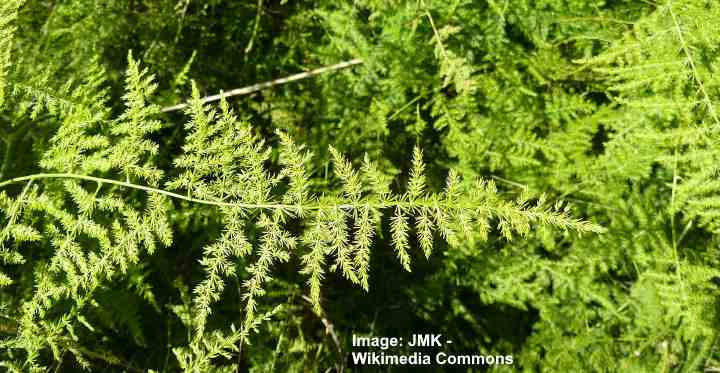
The leaves of asparagus plumosa fern are actually leaf-like flattened stems that are called cladodes
Another feature of asparagus plumosa ferns is their small clusters of inconspicuous white flowers. After flowering, asparagus ferns produce small red berries that contain seeds.
Asparagus plumosa ferns can become invasive in warm climates. In USDA zones 9 to 11, asparagus ferns grow vigorously and can quickly take over backyards. The best recommendation to grow asparagus ferns is to plant it in pots outdoors to prevent them from becoming invasive.
Asparagus plumosa ferns are also delightful, easy-to-care-for houseplants.
How to Care for Asparagus Plumosa Fern – Overview
Grow asparagus plumosa ferns in fertile, loose, well-draining soil. Water plumosa ferns often enough to prevent the soil from drying out. Increase humidity by misting their fern-like leaves daily. Asparagus ferns prefer dappled shade and are kept away from direct sunlight. Fertilize the potted fern monthly during the growing season.
Types of Asparagus Fern
There are 300 species of plants in the family Asparagaceae. There are several species of asparagus ferns, and, according to some sources, seven species of fern are classed as invasive garden weeds. The Asparagus setaceus (also called Asparagus plumosus or Protasparagus setaceus) is one of the most common plants in the species.
Here are more species of asparagus ferns:
Asparagus Foxtail Fern (Asparagus densiflorus ‘Myersi’)
Asparagus foxtail fern has bushy stems that resemble a fox’s tail. The stems are light green and grow in a conical shape. Foxtail ferns grow up to 2 ft. (0.6 m) tall with a spread of 4 ft. (1.2 m).
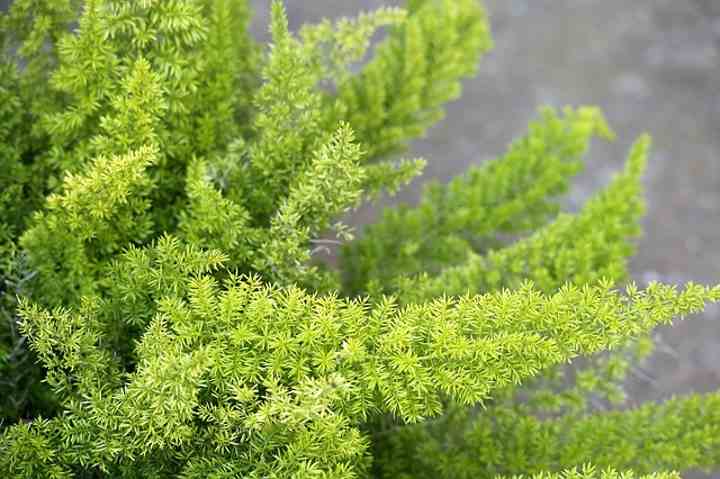
Asparagus foxtail fern
Sprenger Asparagus or Sprengeri Fern (Asparagus densiflorus ‘Sprengeri’)
Sprenger ferns have light, airy foliage that grows on arching stems. Delicate, needle-like leaflets and cascading branches make this ornamental fern-like plant ideal for hanging baskets. Sprengeri asparagus ferns grow to 2 ft. (0.6 m) tall.

Sprenger asparagus fern
Ming Fern (Asparagus retrofractus)
Ming ferns have long thin stems and small needle-like leaves that grow in clusters. The shrubby plant becomes woody as it matures. Due to its growth habit, the plant is sometimes called the zig-zag fern or pom-pom asparagus fern.

Ming fern
Compact Sprenger Asparagus Fern (Asparagus densiflorus’ Sprengeri Compacta’)
The compact sprenger asparagus fern has long feathery stems with shinny green needle-like leaves. Like most species of asparagus ferns, this plant grows small clusters of white flowers followed by red berries.
Asparagus Plumosa Fern Care
Asparagus plumosa ferns are easy-to-grow houseplants. To care for your plumosa fern, grow it in partial shade and moist, well-drained soil. It’s vital to water plumosa ferns regularly and mist them to keep humidity levels high. Asparagus plumosa ferns thrive in average room temperatures. Outdoors, they need protection from frost.
Here is detailed information on how to care for asparagus plumosa ferns.
Asparagus Plumosa Fern Light Requirements
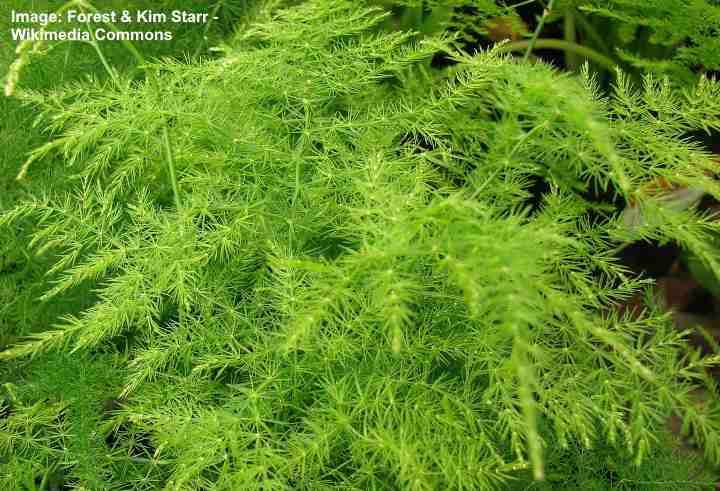
Grow asparagus plumosa fern in dappled shade away from direct sunlight
Asparagus plumosa ferns grow best in dappled shade. You can grow plumosa ferns in a bright room because the plants will adjust to the light. However, direct sunlight can scorch the delicate, airy foliage. Also, too much direct light can dry out the soil too fast and stress the plant.
The best location for an asparagus plumosa fern is in a shaded corner of a bright room. Usually, plumosa ferns grow well on a north-facing window. East-facing windows are also ideal where the plants get plenty of morning sunshine, but no hot midday sun.
To ensure healthy growth and prevent yellowing leaves, always protect the fern-like plant from direct sunlight.
The Best Soil for Asparagus Plumosa Ferns
Asparagus plumosa ferns need moist, aerated soil to thrive. Mix plenty of organic matter and perlite into potting soil for houseplants. Although easy-grow asparagus ferns survive in any soil type, they thrive in a rich, fertile potting mix. Whatever type of soil you use, make sure it’s not soggy.
Perlite is an excellent addition to a potting mix for growing asparagus ferns. The inorganic matter allows excess water to drain freely. The addition of organic matter such as peat moss helps retain just the right amount of moisture.
Ensure that your pot has drainage holes to prevent asparagus fern roots from standing in overly-damp soil.
Related reading: How to make the perfect potting soil for houseplants.
How to Water Asparagus Plumosa Ferns
Water asparagus plumosa ferns often enough so that the soil doesn’t completely dry out. Water the plumosa ferns when the top 1” or 2” (2.5 – 5 cm) of soil is dry. Thoroughly water the fern-like plant until the water drains out the bottom. You may need to water asparagus ferns once a week.
The best guide for watering any asparagus fern is to allow the soil to dry partially. This watering tip helps make sure that the potting mix is never too wet. Also, watering asparagus ferns this way ensures the soil around the taproots is moist but never becomes overly damp and mushy.
When it comes to watering, it’s best to drench the soil thoroughly. Then, allow the excess water to drip out. Deep hydration keeps the roots healthy—as long as you allow the top layer of soil to dry out.
Related reading: The best care tips for watering houseplants.
Best Temperature for Growing Asparagus Ferns
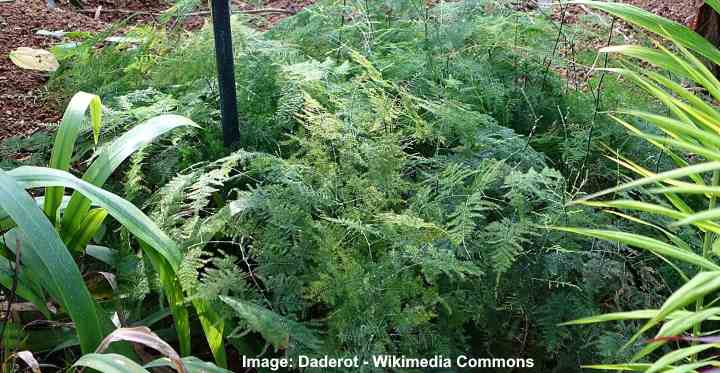
You can grow asparagus plumosa fern outdoors where average temperature is around 70°F (21°C)
The optimal temperature range for asparagus plumosa ferns is 65°F to 70°F (18°C – 21°C). Average room temperatures are ideal for growing asparagus ferns. When growing asparagus ferns as houseplants, it’s vital to protect them from temperature extremes. So, keep the fern-like plants protected from direct sunlight and out of drafts.
Asparagus plumosa ferns are suitable for growing outside in USDA zones 9 – 11. The average temperatures should be around 70°F (21°C) in dappled shade. Asparagus ferns can’t grow in temperatures below 55°F (13°C). Frost will usually kill the delicate evergreen plant.
If you live in colder climates, you can grow asparagus ferns outdoors in containers. These sprawling bushy potted plants are ideal for adding greenery on patios, deck areas, or balconies. Put your potted asparagus fern in dappled shade and protect it from extreme cold or heat.
Humidity for Asparagus Plumosa Ferns
Asparagus plumosa ferns thrive on humidity when growing indoors. To humidify asparagus ferns, spray a fine mist over the bushy foliage daily. Average household humidity is usually inadequate for the plants. The extra moisture encourages fast, healthy growth and prevents the asparagus plant from drying out.
Here are a few care tips to keep asparagus plumosa ferns thriving indoors:
Humidifying water tray—Use a pebble tray to keep asparagus ferns humidified. Put a layer of decorative pebbles in a deep tray. Pour in enough water, so it’s halfway up the stones. Place the asparagus fern pot on the pebbles, ensuring that the container doesn’t sit in water.
Room humidifier—Use a humidifier to increase humidity for moisture-loving houseplants like plumosa ferns. Keep the humidifier at least 50 percent humidity for best results.
Grow plants together—Growing your houseplants close by each other can increase humidity. However, asparagus ferns may still need misting regularly to ensure adequate air moisture levels.
How to Fertilize Asparagus Plumosa Fern
Asparagus plumosa ferns benefit from fertilizer during the growing season. From spring until early fall, apply half-strength liquid houseplant fertilizer. Fertilize plumosa ferns monthly to encourage lush, healthy growth. Alternatively, you can use a slow-release granular fertilizer three times a year—in spring, summer, and fall.
It’s vital to prevent a buildup of mineral salts in the potting soil. Every two or three months, flush the asparagus fern potting mix. To do this, pour water through the soil for two minutes and allow all the excess water to drain out. This plant care technique prevents fertilizer root burn.
After flushing the potting soil, you can resume fertilizing the asparagus fern as usual.
Related reading: The best organic houseplant fertilizers.
Trimming (Pruning) Asparagus Plumosa Ferns
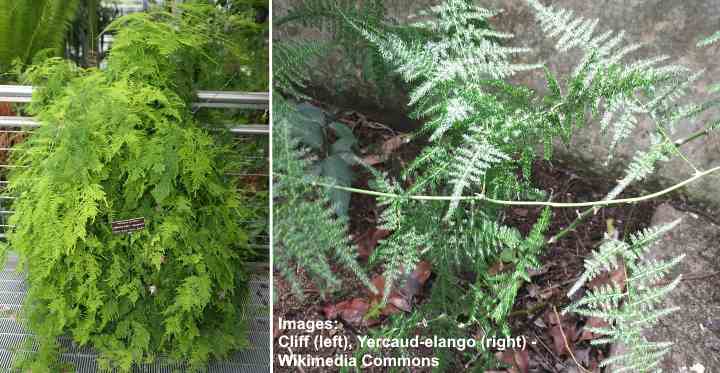
You can prune dead or yellow asparagus plumosa leaves to control the plant’s growth
Prune asparagus plumosa fern foliage in spring to remove dead or unsightly foliage. Although asparagus ferns are fast-growing plants, annual pruning can encourage healthy growth. Trimming the plant also allows you to get rid of yellow or brown cladodes.
To prune an asparagus fern, it’s essential to wear protective gloves. Older plants can develop thorns that lurk under the dense foliage.
Here is how to prune an asparagus fern:
- Cut back old asparagus plumosa stems at the base using sharp, sterilized pruning shears.
- Pinch off stem tips of the asparagus fern to encourage bushy, dense growth.
- Prune yellow or brown asparagus fern stems at the soil level.
- Cut off long stems to help keep the compact shape of the plant.
Repotting Asparagus Ferns
Asparagus plumosa ferns usually require repotting every spring. It’s time to repot an asparagus fern when its roots poke out of the drainage holes. You may also see that water doesn’t drain as freely due to the plant becoming rootbound. Repotting houseplants also allows checking roots for damage.
Here is how to repot an asparagus plumosa fern:
- Carefully remove the asparagus fern’s root ball from its container.
- Shake off the excess dirt and check the roots of your plumosa fern for signs of damage.
- Trim any roots that look brown and mushy.
- Choose a pot that is one size larger than the current one.
- Half fill the pot with a light potting mix.
- Put your asparagus fern in the pot and fill with more soil.
When repotting asparagus plumosa ferns, you can use the time to divide the roots for propagation.
How to Propagate Asparagus Plumosa Ferns
Propagate an asparagus plumosa fern by dividing its bulb-like roots or by planting its seeds. When propagating the plant using root division, ensure that each of the tuber root sections has plenty of shoots. After separating the asparagus fern into two or more pieces, plant in new pots or partially shaded areas of your garden.
Here is how to propagate the asparagus plumosa fern by root division:
- Remove the asparagus plumosa plant from its container and shake all the loose soil off.
- Try to pull the tubers apart into two or more sections.
- Alternatively, lay the plant on its side and use a clean knife to cut through the tuber root.
- Plant the separated tubers of your plumosa fern in a suitable pot and water thoroughly.
Here is how to propagate asparagus ferns from seeds:
- Collect seeds from the berries of your asparagus plumosa fern.
- Soak the asparagus plumosa seeds in some water for a few days.
- Remove the bad seeds that float to the top.
- Plant the asparagus plumosa seeds in soil and cover over with a light layer of soil.
- Water thoroughly and keep the growing conditions warm and moist.
- Seedlings should sprout within two or three weeks.
Are Asparagus Plumosa Ferns Toxic?
Asparagus ferns are poisonous to cats and dogs. Plumosa ferns, emerald feather ferns, sprengeri ferns, and racemose asparagus ferns all contain toxins. Signs that your cat, dog, or pet has ingested parts of the asparagus fern are vomiting, dermatitis, abdominal pain, or diarrhea.
Pests that Can Affect Asparagus Plumosa Fern Growth
Pests rarely affect asparagus ferns. If you get problems with houseplant bugs on your asparagus ferns, they are usually scale insects or mealybugs. It’s vital to treat pests on plumosa ferns as soon as possible. Scale and mealybugs suck juices out of the plant and weaken its growth.
To treat pests on asparagus plumosa ferns, use a neem oil solution. Mix 1.5 tsp. organic neem oil and 1 tsp of mild dish soap with 33 fl. oz. (1 l) of warm water. Fill a spray bottle and shake well. Spray your infested asparagus ferns once a week to get rid of scale or mealybugs.
Related reading: How to get rid of houseplant pests naturally.
Diseases that Can Affect Asparagus Plumosa Growth
Fungal root rot is the most common disease to affect asparagus plumosa growth. To avoid root disease, never overwater your ferns. You can do this by only watering when the soil is partially dry and ensuring that water drains freely from the pot. Avoid keeping asparagus ferns in dark environments.
Signs of asparagus fern root rot include yellowing leaves, wilting growth, and red discoloration on the stalk bases.
If you notice signs of disease, remove the plumosa fern from its container. Check the roots for brown diseased tubers and use sterilized equipment to cut off the affected parts.
FAQs About Asparagus Plumosa Fern Care

Asparagus ferns require minimal care for them to grow healthy. However, there are a few factors that can affect their care.
Why is my asparagus fern yellowing?
The leading cause of yellow asparagus fern foliage is too much sunlight. Other reasons why asparagus plumosa can have yellow leaves are too little light or too much water.
Asparagus plumosa plants need some sunlight but require protection from prolonged direct sunlight. If you notice yellowing leaves, move the asparagus fern to a shadier location.
Yellow asparagus plumosa leaves could also be a sign of too little light. Unlike true ferns that thrive in dark, damp conditions, asparagus ferns need some light, plenty of warmth, and humid conditions.
Asparagus fern leaves could also turn yellow because of too much water. Overly-damp soil conditions drown the roots and don’t allow them to get enough oxygen. So, only ever water an asparagus fern when the soil dries partially.
Do asparagus ferns have bulbs?
Asparagus ferns have underground bulbs called tubers. The fleshy roots are excellent for retaining moisture. It’s the asparagus fern bulbs that you divide when you want to propagate the plant.
Related article:
- Varieties of Indoors and Outdoors Fern Plants
- Types of Asparagus Fern: Foxtail, Plumosa, Sprenger
- Asparagus Foxtail Fern (Asparagus Meyeri): Care Guide
